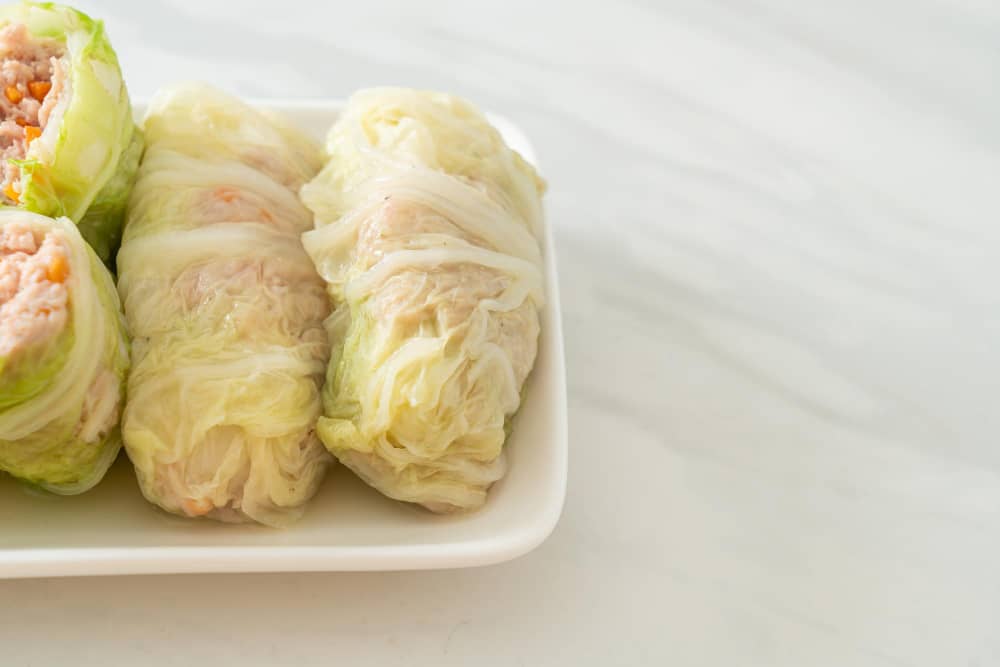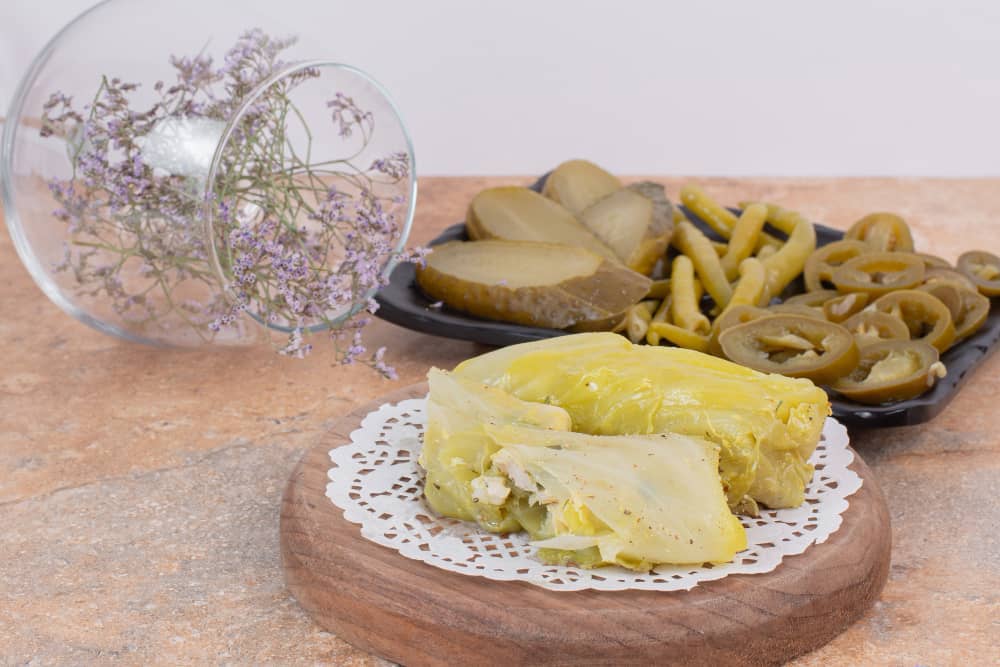This Sauerkraut recipe is surprisingly easy to make at home. It is made by fermenting cabbage with salt and water, which creates a tangy taste and a unique texture. The process of fermentation also adds beneficial probiotics to the sauerkraut, making it a healthy addition to any diet.
This sauerkraut recipe is low in calories, but it is high in dietary fiber and protein. It is rich in Iron, promotes digestive health, improves heart health and more. It has originated more than 2,000 years ago in China and it is the most well-known Lacto-fermented vegetable.
This sauerkraut recipe is wonderful! I was a little hesitant to try it, but it turned out great. The sauerkraut is tangy and crunchy, and the flavors meld together perfectly. I will definitely be making this again.
Print
Sauerkraut recipe
- Total Time: 672 hours 15 minutes
- Yield: 8
- Diet: Vegan
Description
Sauerkraut is low in calories, but it is high in dietary fiber and protein. It is rich in Iron, promotes digestive health, improves heart health and more. It has originated more than 2,000 years ago in China and it is the most well-known Lacto-fermented vegetable.
Ingredients
- 3 lbs head green cabbage
- 1½ tbsp kosher salt
- 1 tbsp caraway seeds
Instructions
- First make sure you have clean and washed mason jar, and jelly jar and rinsed of all soap residue. Always rinse your hands well.
- Take the cabbage and slice it, and remove limp outer leaves, discard wilted. Cut it into quarters and trim out the core. You can use a cutting board to slice each quarter, making 8 wedges down its length. Then each wedge slice crosswise into very thin ribbons.
- In this step, you have to massage the cabbage with salt. For this step, you’ll have to transfer the cabbage to a big bowl and sprinkle the salt over the top. Keep massaging with the salt and squeezing the cabbage with your hands. Massaging the cabbage with salt makes the cabbage more watery and limp. You can do this for about 5 to 10 minutes. If you’ll be using caraway seeds, now it is the time to add them.
- Now it comes to use the jar. Fill up the jar with the cabbage into the canning jar. Use you fingers to push down the cabbage in the jar. Pour any liquid released by the cabbage while you were massaging it into the jar.
- Now put the smaller jelly jar into the mouth of the bigger jar and you can add weigh such as marbles or clean stones to keep the cabbage weighed down with its liquid.
- Then cover the mason jar with a cloth and secure it with twine or a rubber band.
- The cabbage will become more limp and compact as it releases liquid, and that liquid will rise over the top of the cabbage.
- You can mix 1 teaspoon of salt in 1 cup of water and add enough to submerge the cabbage, only If after 24 hours, the liquid has not risen above the cabbage.
- Put the jar into a cool room temperature between 65 to 75 degrees Fahrenheit, away from direct sunlight exposer. If the temperature is too high the sauerkraut can go bad. Make sure you check it every day and press it down if you see any cabbage floating above the liquid. After 2-3 days you’ll start tasting it. You can remove the weight, screw on the cap, and refrigerate, when the sauerkraut tastes good to you.
- Because the sauerkraut has been fermented you can keep for at least 2 months or longer if you keep it refrigerated.
- You can use your imagination and serve this sauerkraut recipe with a shredded carrot on top and sprinkle some fresh green onion or some herbs.
- Prep Time: 15
- Cook Time: 28 days
- Category: Salads
- Method: Fermentation
- Cuisine: Germany
Sauerkraut Recipe FAQs
How long do you let homemade sauerkraut sit?
It depends on the sauerkraut recipe you use and your own preference. Generally, homemade sauerkraut should be allowed to sit for at least three weeks in a cool place before eating. This will give it enough time to ferment and develop its signature sour flavor. If you prefer a more intense flavor, you can let it sit for up to six weeks or longer.
When letting your sauerkraut sit, make sure that the container is airtight so that no air can enter and spoil the fermentation process. You should also check on it periodically to ensure that there is still liquid covering the cabbage, as this is necessary for successful fermentation. If you notice any mold forming on top of the liquid, simply skim it off with a spoon and discard it.

What are 3 vital things to look for when buying sauerkraut?
When purchasing sauerkraut, there are three important things to consider. First, check the ingredients list. Sauerkraut should only contain cabbage and salt; any additional ingredients such as preservatives or artificial flavors should be avoided. Second, look for organic sauerkraut if possible.
Organic sauerkraut is made without any synthetic pesticides or fertilizers, so it’s a healthier option than non-organic varieties. Finally, make sure to read the expiration date on the packaging. Sauerkraut can spoil quickly if not stored properly, so it’s important to buy a product that is still fresh and hasn’t exceeded its shelf life. By following these simple tips, you can be confident that you’re buying the best quality sauerkraut available.
What factors affect sauerkraut fermentation?
The fermentation of sauerkraut is affected by several factors, including temperature, salt concentration, and the presence of bacteria. Temperature is perhaps the most important factor in sauerkraut fermentation, as it affects the rate at which the bacteria will grow and convert sugars into lactic acid. Generally speaking, temperatures between 60-70°F are ideal for sauerkraut fermentation. Too high of a temperature can lead to undesirable flavors and off-odors while too low of a temperature can slow down or even halt the process altogether.

What is the best time to make the sauerkraut recipe?
The best time to make the sauerkraut recipe is late summer or early fall. During this time, the weather is mild and the cabbage is at its peak, making it ideal for fermentation.
When making sauerkraut, it’s important to use fresh cabbage and other ingredients. If you wait too long after harvesting your cabbage, the quality of your sauerkraut will suffer. The fermentation process also works best in moderate temperatures, which are more likely during late summer and early fall.
In addition to using fresh ingredients and mild temperatures, it’s important to have patience when making sauerkraut. Fermentation can take anywhere from two weeks to three months, depending on the desired flavor and texture. By following these steps and timing your sauerkraut-making correctly, you’ll be able to enjoy a delicious batch of homemade sauerkraut!
Final Words
In conclusion, sauerkraut is a fantastic way to add flavor and nutrition to your meals. This sauerkraut recipe is simple, yet delicious, and can be adapted in many ways to suit your own tastes. We hope our recipe has given you the confidence and inspiration to give it a go and make some of your own homemade sauerkraut. Don’t forget that fermented foods are extremely beneficial for your gut health and immunity, so why not make a batch today!
Disclaimer
The information contained in this post is for general information purposes only. These statements have not been evaluated by the FDA and are not intended to diagnose, treat, cure or prevent any disease or health condition. If you have specific healthcare concerns or questions about the products displayed, please contact your licensed healthcare professional for advice or answers.

